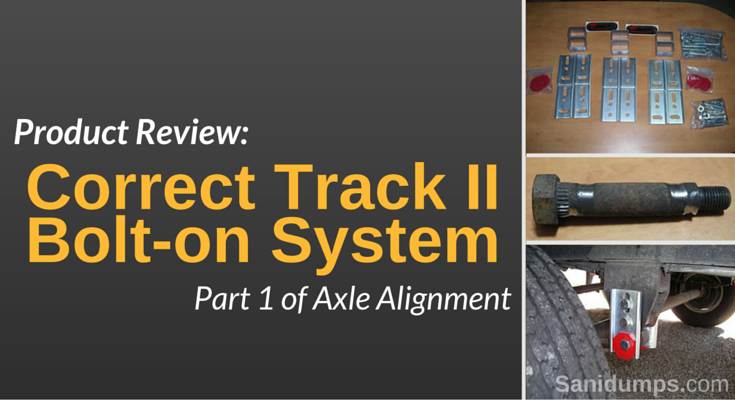
John’s Report
* See Company Information Update/Change Below
My fifth wheel trailer is only three years old and I have nearly worn out six tires, two on the front and four on the rear, all unevenly.
History
I picked up the RV in Indiana and delivered it home. We took a few smaller trips in the following years and I had not noticed any uneven tire wear. If I had used a tire wear gauge I would identify the issue. I have never done so in the past.
For our big trip for 2010, starting in British Columbia we would head south to Colorado then east to Nova Scotia and back to British Columbia through three provinces and twenty states.
While at a RV dump station dumping the holding tanks in southern Colorado, I noticed that the rear tires of the trailer were wearing a lot more on the inside than the outside. This is not good!
So thinking the axles were out of alignment, I found the nearest location to align the trailer axles in Northeast Arizona. Even though I could see the problem was with the rear tires wearing, I had the alignment shop align both axles. Due to lack of tread on the inside part of the rear tires, I replaced the rear tires.
Off we went, this time, I was checking the tires every hundred miles or so, to see if there was any uneven tread wear. None was observed. In Nova Scotia, I could see that the rear tires were wearing on the inside again! I couldn’t find a shop that could align the RV, but I did find a shop that worked on large trucks. They did not see any issues, but they were not alignment shop.
I continued our trip while monitoring the tires at each stop. I decided that I would replace all four tires at the end of this trip and monitor the new tires with a tread gauge. See current status of the tires below.
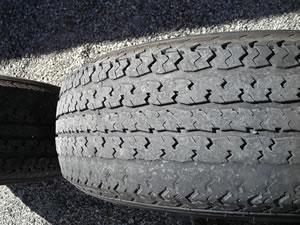
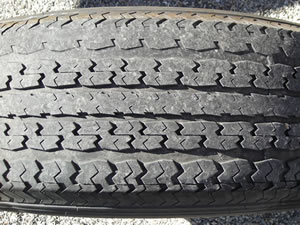
Research
Searching on the internet I found that there were many other RVers with a similar problem with tire wear and getting the axles aligned didn’t always solve the problem. I believe this is a common problem but most RV trailers do not exhibit it as they most do not have a lot of mileage. Most RV tires age due to damage due to UV then from tread wear. Many RVers blame their tire manufacturers rather than checking alignment. I needed to resolve this issue to ensure road safety for my family.
My search showed that there are two alignment methods currently been deployed. One, aligning the wheels to the frame which is how cars and trucks are aligned and second, aligning to the tow point (a king pin for 5th wheel and hitch point for trailers). Aligning to the pin was the right method for me as it eliminates any framing errors or king pin not centered correctly. I found the company Rieco Titan Products Inc. produces several products for the RV industry including the Correct Track II Trailer Correction Alignment Kit that enables you to align your axles to the towing point of your RV.
They recommended that you take initial measurements A, B, C, D as per diagram below after parking your RV on solid even ground. The first is to take your measurements on level ground. Taking measurements is a two-person task. Make sure you drive straight before you stop to eliminate any side torque on the tires and the shackles are relaxed between the front and rear tires (the Y yoke is centered). Once the trailer was level, I used a plumb-bob to mark the location of the king pin on the ground. This marked the starting point for measurements A and B. I used a 12″ square in front of the tire tread with long edge on the ground and short edge against the tire tread. This became the end points for A and B. For C and D, I measured from the center of front axle to center of rear axle. The locations on the axle are not that critical as long as one is consistent and repeatable.
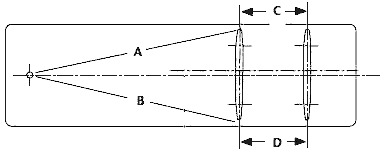
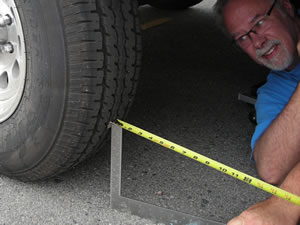
The measurements ‘A’ and ‘B’ should be within 1/8″ of each other (per Riecotitan Products Inc.) and the measurements ‘C’ and ‘D’ should also be within 1/8″ of each other also. My measurements ‘A’ and ‘B’ were 1/2″ out and the measurements ‘C’ and ‘D’ were 3/8″ out.
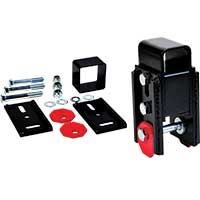
Kit Contains
The kit weighs twenty-nine pounds and contains the following:
- Equalizer / Center hanger plates
- Spring hanger plates
- 2 x 3 x 1 7/8″ spacers
- 1/2″ 20 x 3 1/2″ bolt
- 1/2″ locking nuts
- 1/2″ washers
- 9/16″ x 4 ” bolts
- 9/16″ locking nuts
- 9/16″ washers
- Correct Track cams with 9/16″ hole
- Instruction Guide
Tools Required
- Plumb Bob
- Tape Measure
- Marking Pen
- Jack Stands
- Floor Jack
- 1/2″ Electric Drill
- 1/4″ Drill Bit
- 1/2″ Drill Bit
- Wrenches
- Tourque Wrench
Other Tools I Used
- 12″ square
Installation
I found the video on the website very helpful and recommend watching it more than once before you start to install the Correct Track Trailer Correction Alignment Kit. The instructions supplied are clear and easy to follow. The following are some of my notes that may help if you are DIY and installing the Correct Track II kit.
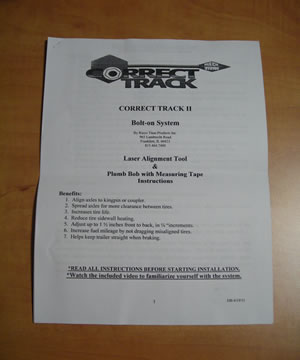
I then laid out all the parts to make sure nothing was missing but also to ensure that I’m familiar with the parts that I will be installing and that I don’t have any “spare” parts left over when I’m finished – lol.
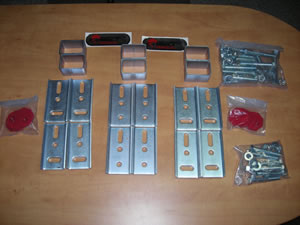
Normal installation requires you to install the kit on the center hanger similar to the ones installed at each end. Since I have a MOR/ryde® suspension system on the trailer. I do not want the replacement hanger between the two axles. I contacted Riecotitan Products Inc. and verified that I could continue the installation using the MOR/ryde® suspension system. The answer was yes you can install the Correct Track II system with the MOR/ryde® system and other suspension systems.
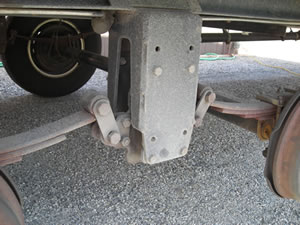
When working on your trailer suspension system you should always inspect tires, hangers and linkages for abnormal wear and tear. This should be a maintenance step at the start out of each RV season. Even though my trailer is only a few years old I was surprised with the amount of wear. Take a look at early warning sign below; can you see the elongation of the hole in the shackle link? The bolt is worn as well as it has worn the shackles. This would affect the tread wear too. Manny RVs have plastic bushings installed over the bolt to reduce this wear. Most RVers do not drive long distances, and it works but for others that do drive their RVs like me, these plastic bushings are totally inadequate.
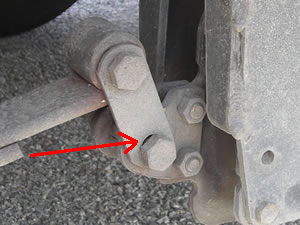
Since there was lots of wear with the shackle links and bushings, I replaced all the shackle links, shackle bolts, bushings and nuts. Below are images of some shackle parts, the other parts were of the same condition – poor and needing replacement! Six of the eight bushings were completely worn out as you can see below in the image!
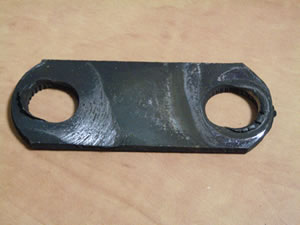
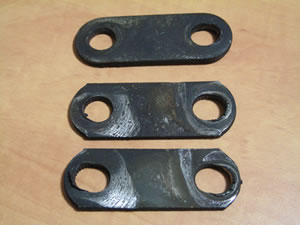
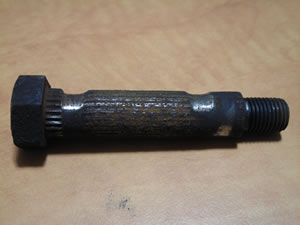
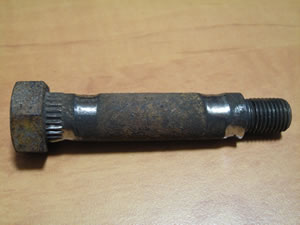
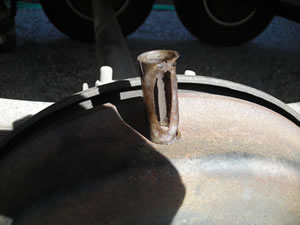
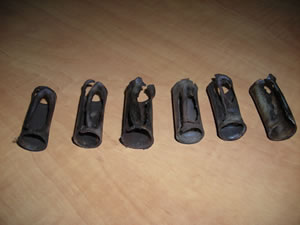
Here’s an image of the Correct Track II hanger installed. The designers of the Correct Track II systems made a 1/2″ diameter slot to aid DIY installers (as it is more common drill a bit unlike 9/16″ diameter). My unit required a 9/16″ diameter hole. This required me to align the hanger in the kit using the bottom bolt and mark the position of the top bolt. Using a round file, I expanded the slot area for the top bolt. This picture was taken before I adjusted or tighten the bolts.
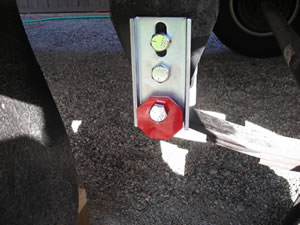
Since the supplied brackets extend below the existing trailer hangers, my RV by two inches. As I mentioned earlier, I did not install the center hanger as I have Mor/ryde system installed instead of a center hanger. In order to level the trailer when towing, I had to adjust (raise) my king pin as shown below.
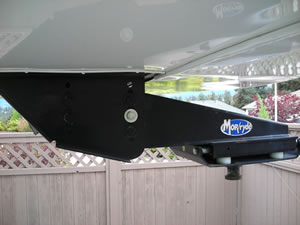
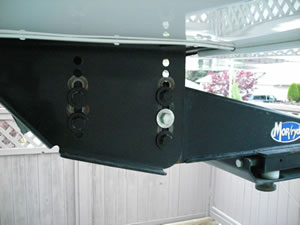
Results
The installation of the Correct Track II Trailer Correction Alignment Kit went very smoothly. The engineers at Riecotitan Products Inc. were very responsive in answering any questions. I installed the kit by myself over a two-day period, it could have easily been installed in a day, but I had to go to three places to find replacement shackle links, shackle bolts, and nuts.
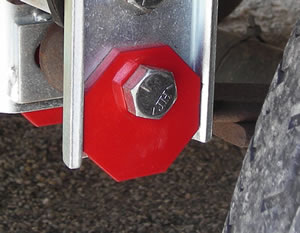
During the installation I set each of the cams to the neutral position. After I installed the kit I re-took same measurements without making any changes to the cam settings.

Measurements: After installing the kit and cams in neutral/default position
(For easy comparison, all fractions of an inch is reported as in sixteenth)
| A | 236 8/16″ |
| B | 236 2/16″ |
| C | 34 5/16″ |
| D | 34 2/16″ |
The difference between measurement A and B is 6/16″.
The difference between measurement C and D is 3/16″.
Measurements: After making the appropriate adjustment by rotating the cams
| A | 235 4/16″ |
| B | 235 6/16″ |
| C | 34 3/16″ |
| D | 34 4/16″ |
The difference between measurement A and B is 2/16″ an improvement of 4/16″.
The difference between measurement C and D is 1/16″ an improvement of 2/16″.
Your measurments most likely will be different, Correct Track II can adjust for an 1/2″ at each hanger in 1/4″ increments. So in theory you could move one side forward 1/2″ and the other side backward 1/2″ for a 1-inch correction.
Passenger side of RV
Rear – Front
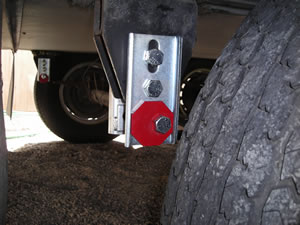
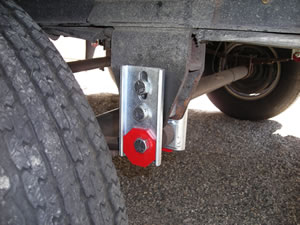
Driver side of RV
Rear – Front
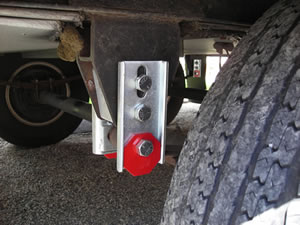
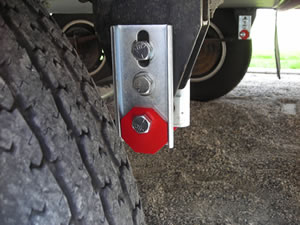
Final touch – install Correct Track II decal.
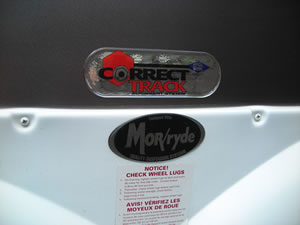
Lastly, I have replaced my tires (see old tires above). The first short trip the trailer felt like it had less pulling resistance and tracked straighter behind my truck. Stay tuned for more long term usage data as I drive more miles.
Happy RVing,
John
Company Information
Rieco Titan Products Inc.
965 Lambrecht Road
Frankfort, IL 60423
815.464.7400
Note: Company Information Update (2012-03-28)
The Correct Track II Trailer Correction Alignment Kit is now supplied from The Mobile Outfitters.
The Mobile Outfitters
2703 County Road 36
Goshen, Indiana
46528
USA
574.971.4100
The Mobile Outfitters
2012-05-09 Update
I received an email from Robert asking for an update “How are your RV tires doing since the Correct Track II install”. I hadn’t measured the tire wear this year, so I took out the tire tread gauge and measured the tires. I’m happy to see that the tires are wearing evenly 🙂

